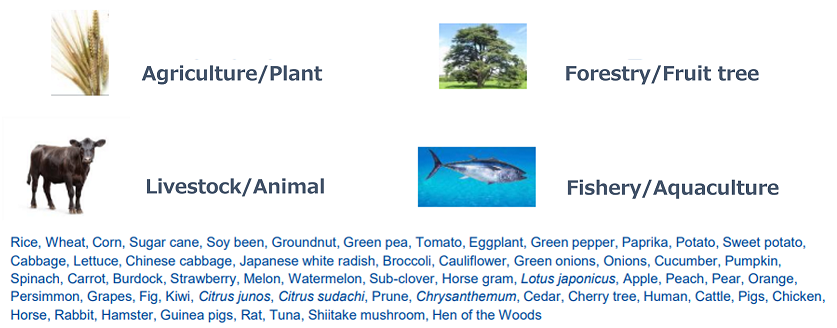Introduction
GRAS-Di® (Genotyping by Random Amplicon Sequence-Direct) a reduced representation, amplicon-based skim sequencing method to cover the whole genome.
This technology enables the discovery and genotyping of SNP markers for agricultural or biodiversity studies.
GRAS-Di can be implemented to identify genetic variations within populations or to develop marker/trait associations for selective breeding purposes.
GRAS-Di has been implemented successfully in over 120 different species including crops, forestry, livestock and aquaculture. One of the major strengths is the wide applicability to diploid as well as highly polyploid species.
Please refer to the Bibliography here for further details.

Advantages
- More cost effective than whole genome deep sequencing
- Economical & ecological, simple method able to process low-quality DNA or slightly fragmented DNA (>100ng)
- Applicable to both natural and segregated populations, all without the need for a reference genome
- Acquires fewer missing data than (dd)RADseq
Technology
GRAS-Di® amplifies random regions across a genome using random primers. Samples are pooled and the amplicons are sequenced using Illumina Next Generation Sequencing. Sequencing reads are aligned between samples to identify and genotype SNPs.
More detail, please refer to this PDF file
| sample# |
Illumina platform |
Lane |
Sequence data |
| 96 |
NovaSeq6000 |
Multiplex
Sequencing |
500M reads/total |
| 192 |
NovaSeq6000 |
Multiplex
Sequencing |
1G reads/total |
| 1000 |
NovaSeq6000 |
1 |
4-5G reads/total |
Applications
Applicable for genetic diversity studies, polymorphism detections (SNPs or InDels or Haplotypes).
Increased usage in the field of phylogenetic and population structure studies.
Please refer to the Bibliography here for further details.
SNP Discovery
- Develop SNP markers for translation to a preferred genotypng system
- High quality alternative to GBS, WGS, RNA-Seq or (dd)RAD-Seq
High Throughput Genotyping
- Discover and genotype massive amounts of genetic variants for Marker Selection
- High-density Linkage Mapping & QTL Mapping, Chromosome Mapping, Phylogenic and Population structure studies
Others
- Potential of large number of polymorphisms used as molecular markers for genetic analysis
- Possible to obtain genome-wide co-dominant markers
- Identify many markers covering all chromosomes even in a population with small genetic variation
Deliverables
- Raw data in FASTQ format
- Genotyping results with dominant markers
- Genotyping results with co-dominant markers
* Available only in case of diploids, segregated population & homozygous parents, more than 40 samples of F2 generation.
- Mapping result of dominant markers to the reference genome
* Available only for the species whose reference genome is available
(Optionally) Mapping & SNP call result
(1) Mapping result (BAM format)
(2) SNP call result (VCF format)
Case Studies

Sugar Cane variety NiF8 and Ni9 and 22 progenies were analysed with technical replicates (red boxes) by sequencing 32 samples in one lane on HiSeq 2500. The presence (pink) or absence (green) of markers were identified by the achieved read depth (Fig.1).
With the use of GRAS-Di, 8,683 and 11,655 markers were identified in the parental lines with high reproducibility (N=2, 99.96%). Moreover, when mapped on the reference markers show a very uniform distribution over the chromosomes(Fig.2). From TOYOTA Presentation at PAG2018 (The Plant and Animal Genomics XXVI Conference).
FAQ
- Q1 How many different amplicon species and how many SNP markers can be obtained by using GRAS-Di?
- A1 The number of different amplicon species and SNPs that can be identified by GRAS-Di depends on the genome size of the sample species, the population type (segregated or natural), genetic diversity of the population, and amount of sequence data for each sample. As an example, if you sequence 2M read pairs (4 M reads) per sample, 100,000 to 1 million different amplicon species can be obtained, though this can be tuned using different primer pairs, according to the needs of the study. We set a threshold for SNP calling at >30X coverage, which will typically identify approximately 10,000 SNPs, though this depends greatly on the SNP density within the target species. Experimental parameters may be adjusted according to the expected number of SNPs.
- Q2 Do you have any recommendation about sample multiplexing?
- A2 The current protocol recommendation requires a minimum of 2M read pairs (4M reads, 0.4Gb using 100bp read length) per sample. Illumina NovaSeq 6000 can generate an average of 4-5G reads per sequencing lane, so can accommodate 1,000 samples.
- Q3 Are co-dominant markers detectable by GRAS-Di analysis?
- A3 Yes, co-dominant markers are detectable in diploids, from segregated population and homozygous parents.
- Q4 Can you provide any references citing the use of GRAS-Di technology?
- A4
 Please refer a Table (PDF).
Please refer a Table (PDF).
- Q5 How to prepare the DNA samples for the GRAS-Di analysis ?
- A5 Please refer the followings.
- It is mandatory to determine the DNA concentration with UV methods.
- Please provide us with at least 600 ng of high molecular weight genomic DNA per sample.
If possible, please supply us with the 2-3 fold amount of DNA.
- The min conc. Required is 30 ng/µl.
- Please contact us if your samples do not meet the requirements.
- Eurofins Genomics K. K. recommends dilution in Tris-EDTA buffer or buffer supplied by manufacturer of commercial DNA extraction kits.
- Q6 How to ship the DNA samples?
- A6 Please contact to